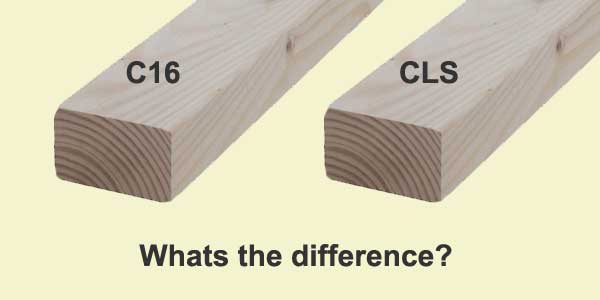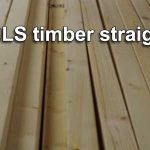In this article, we will be looking at the difference between C16 and CLS. These are actually two different things, but they are both common terms you will hear relating to timber.
When it comes to buying timber, there can be some confusion with different names for the wood you are buying. Some common terms you might hear include:
- C16
- C24
- CLS – Canadian lumber standard
- PSE – Planed straight edge
- Scant
- Sawn timber
- Planed timber, finished timber
- Eased edge – Both planed and sawn
- Treated, pressure treated, tanalised
- Untreated
- Ungraded
The above terms all refer to one of the following:
- Strength grade
- Timber finish
- Or whether the timber is treated
Two very common terms you will hear, are C16 and CLS. These are actually two completely different things. However, the same piece of wood could be C16 graded and still be a piece of CLS.
CLS stands for Canadian lumber standard. It is a high-quality cut of timber, first developed in Canada for timber frame housing construction.
The timber is planed on all sides and has distinctive rounded corners. As a result, the wood is smaller than a sawn timber and has a smoother, higher-quality finish.
For example, the dimensions of 3×2 CLS are 38 x 63mm. This is compared with 50 x 75mm for a sawn 3×2.
CLS is also a strength graded timber. This grading can be either C16, or C24. C16 is the most common of the two and is what you will generally find when you buy CLS.
So, this is the difference between the two. CLS was first developed in Canada, it is the way the wood is planed and finished. On the other hand, C16 is a strength grading, that meets The British Standard for Timber Structures.

Different types of CLS and its uses in the UK
As we have previously mentioned, CLS was first developed and used in Canada. Its main use is in timber framed housing.
Due to its planed sides and rounded corners, it is easy to work with, making it ideal for this type of work. It also meets Canadian strength grading standards, which are similar to the ones used in the UK.
In the UK, CLS is mainly used for internal studwork. Again it is extremely popular, due to its finish, which makes it easy to handle and work with. It also tends to be good quality, straight timber making it ideal for building stud walls.
CLS generally comes in two sizes. These are:
- 38 x 63mm
- 38 x 89mm
The equivalent sawn sizes would be 50 x 75mm (2×3 inch) and 50 x 100mm (2×4 inch). Both of these can be used in studwork. The one you choose will depend on a variety of factors. However, 3×2 tends to be the most common.
4×2 will produce a stronger structure, so it is better for higher ceilings. It also gives more room for things like insulation between the studs.
You can also improve strength further, based on the timber grading you choose. C16 is most common, but you can also buy CLS that is C24 graded. This will be straighter on average, with fewer and small knots, it will also have less defects in general. Essentially it is just a higher quality piece of wood.
However, you should remember, if this is being used for studwork, it will be hidden, and a higher strength grade will be more expensive.
Treated or untreated CLS
Another variation you will often see with CLS timber, is treated and untreated. This refers to pressure treatment, which makes the timber more suitable for outdoor use.
This is done by using pressure to drive chemicals into the wood, which protect it from rot and mould. As well as providing protection against wood burrowing insects, such as woodworm.
Treated timber is perfect for outside applications and can be used for a variety of different things. Due to its finish, it looks good, so it can be used as an exposed timber in things like outdoor furniture and other types of features.
Treated timber can also be used indoors as a precautionary measure. This is quite common when replacing timber after internal problems. This could include things like damp, leaks, or any kind of damage caused by things like rot and woodworm.
Generally, treated timber isn’t that much more expensive than untreated. Therefore, it is quite common for it to be used indoors for things like studwork. Especially if you are trying to prevent previous issues from returning.
Conclusion
As you can see, CLS and C16 are actually completely different things. However, at the same time they can often be talking about the same piece of wood. The main difference is CLS is graded, so it has to be either C16 or C24.
On the other hand a graded timber such as C16 doesn’t have to be CLS. It could be any type of timber. For example:
- PSE – This is another planed timber with a slightly different finish and dimensions
- Scant – This is another
- Rough Sawn timber
- Etc
CLS is also most commonly associated with studwork timber. Whereas graded timber could be anything, from studwork to floor joists, to roof rafters and trusses, to timber decking. Basically any type of timber that is graded for high quality and strength.




